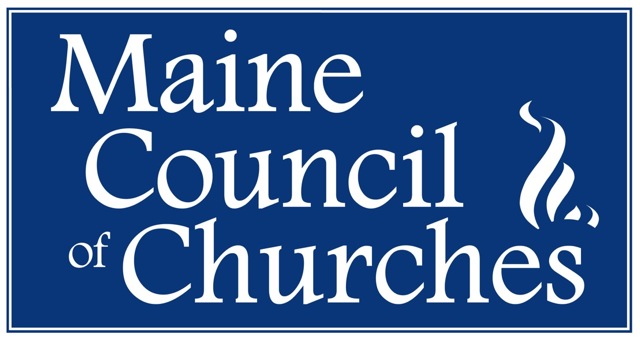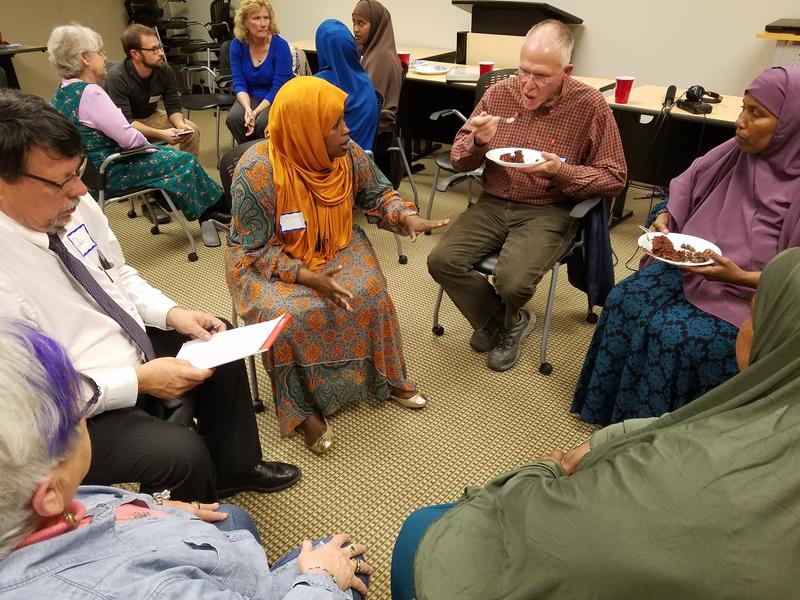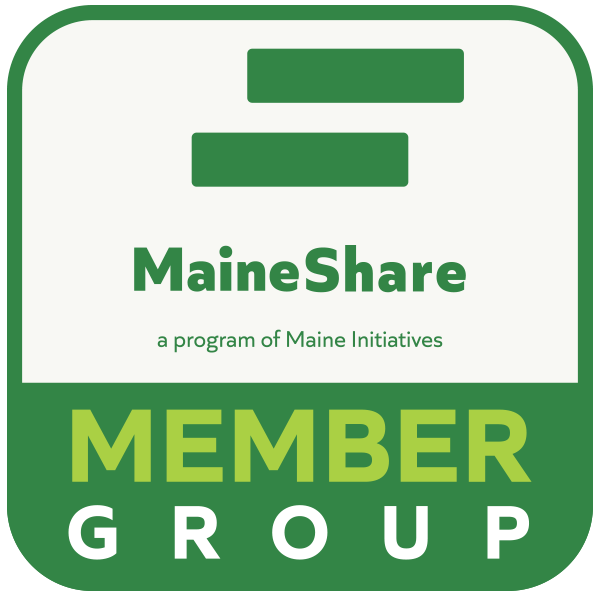For the past several weeks, “new” Mainers have been breaking bread with longtime residents of Lewiston and Auburn, swapping stories about their families and breaking down stereotypes about immigrants and refugees.
It’s part of a national initiative to address the uptick in hate crimes. One focus of the sessions is to teach bystanders how to safely intervene in a bias incident before it escalates.
Building relationships with strangers doesn’t happen on an empty stomach, so part of each conversation involves a meal. In this case, it’s a Somali potluck dinner featuring a savory pastry called sambusa served up in the basement of the Community Concepts building in Lewiston.
This is just one of nearly 20 facilitated discussions that wrap up this month. Each group meets twice, and their discussions span several hours and cover provocative themes about race, religion and prejudice — like the misperception that anyone from Somalia is a terrorist.
“No, we’re not terrorists. As a matter of fact terrorists attack everyone equally. They harm Muslim people too,” says Fowsia Musse of Lewiston translating for Ayan Ali, one of several Somali women taking part in the group. “As a matter of fact, I don’t think terrorists and I have the same religion or beliefs. I don’t think they’re normal people either. I would like the world to eradicate all terrorists, because they cause us a lot of grief. They cause us a lot of shame because they look like us. They wear the same clothes as us.”
Facilitator Steve Wessler has the group discuss several other stereotypes about new Americans: that they’re lazy, don’t want to work and are all on welfare. And then Wessler, with help from the group itself, breaks them down one by one.
“Are these accurate about new Americans being lazy?” he says.
“My experience is no,” says Glen Holmes, director of economic development for Community Concepts Finance Corporation and a native Mainer who lives in Buckfield. “Some of the most hardworking, dedicated people I’ve met have been new Mainers.”
“They take the jobs that other people feel they’re too good for,” says Tara Saunders.
But Saunders says one of the reasons she’s participating in the discussion is that she has a lot to learn about how refugees and new immigrants receive aid. She says other people she knows don’t understand that either.
“And so, therefore, we put our own assumptions. And I think what most people need to be is much better informed what the aid is,” she says.
One of Wessler’s exercises involves arming members of the group with statistics about the type of aid immigrants receive from the government, how much they contribute to the economy and their rate of home ownership.
Wessler has been doing civil rights and conflict resolution work in Maine and around the world for more than 25 years. This project, funded by a small grant in partnership with the Maine Council of Churches and the Maine People’s Alliance, is similar to one he did about a decade ago.
“Things got better in Lewiston, and I think there has been somewhat of a going backward perhaps. There’s a lot more anti-immigrant, anti-refugee bias,” he says.
Between 2015 and 2016, the Maine Department of Public Safety reported a 5 percent increase in the number of hate crimes in Maine. And since last year, there has been a documented increase in the number of bias-motivated incidents of harassment and violence targeting Muslims, Jews, members of the LGBT community and immigrants across the country.
And so, Wessler says, the way to reduce that is to not only confront stereotypes, but to teach people how to speak up and respectfully intervene when they hear a degrading comment or see a possible bias-motivated incident unfolding.
He uses the example of a woman who intervened on behalf of a 16-year-old Somali girl named Sara.
“She had gone to the laundromat with her mother to wash the clothes. It was winter and people were coming in with dirty snow on their shoes and the floor was not clean,” Wessler says.
The story goes that when Sara turned away to get some more quarters to fill the dryer, a white woman came over, took the clothes out, dumped them on the dirty floor and started kicking them around.
“While she was saying things like, ‘We don’t want you here. Go back to Somalia.’ And then [Sara] felt a tap on her shoulder and and she looked up and saw a white-haired woman. And the woman said: ‘I’m so sorry that woman did that, but she doesn’t represent everybody in Lewiston. Many of us are so glad that you are here,’” Wessler says.
And then the woman helped Sara pick up the clothes to be washed a second time. And while she walked over to her mother to get some more quarters, the woman paid for the load of wash and quietly left the laundromat.
Wessler says that when Sara looked back on what happened, she put her hands to her chest and said, “That woman healed my heart.” It’s a kind of healing that works both ways for members of the groups.
“I have heard the stereotypes. I have not necessarily addressed them. I think my silence says a lot. I’m eager to learn more,” says Claire Hebert of Turner.
Hebert says she’s been forced to consider her failure to speak up for her new Somali neighbors, in part because of a lack of understanding about their culture. But at her first meeting, after hearing examples of some of the disparaging, disrespectful comments made to Somali students at Lewiston High School read aloud, Hebert says she was so upset, she got up and approached the Somali women in her group.
“There was no single word that I could think of that would make up for the words they were hearing, so I knelt down and I bowed to them and I said, ‘Please forgive us.’” she says.
Afterward, Hebert says, the Somali women came up and embraced her one at a time. No translation needed.
Supporters of the initiative, known as Communities Against Hate, hope that the message and the training can be replicated in other parts of Maine.


